Working in International Teams: Importance of Culture and Teamwork
VerifiedAdded on 2023/01/05
|11
|3366
|51
AI Summary
This report explores the importance of culture and teamwork in working in international teams. It discusses the impact of culture on team dynamics and the role of effective team working models. The report also highlights the use of Kantor's Four Layer Model and Hofstede Cultural Dimension Model in understanding and managing cross-cultural teams.
Contribute Materials
Your contribution can guide someone’s learning journey. Share your
documents today.
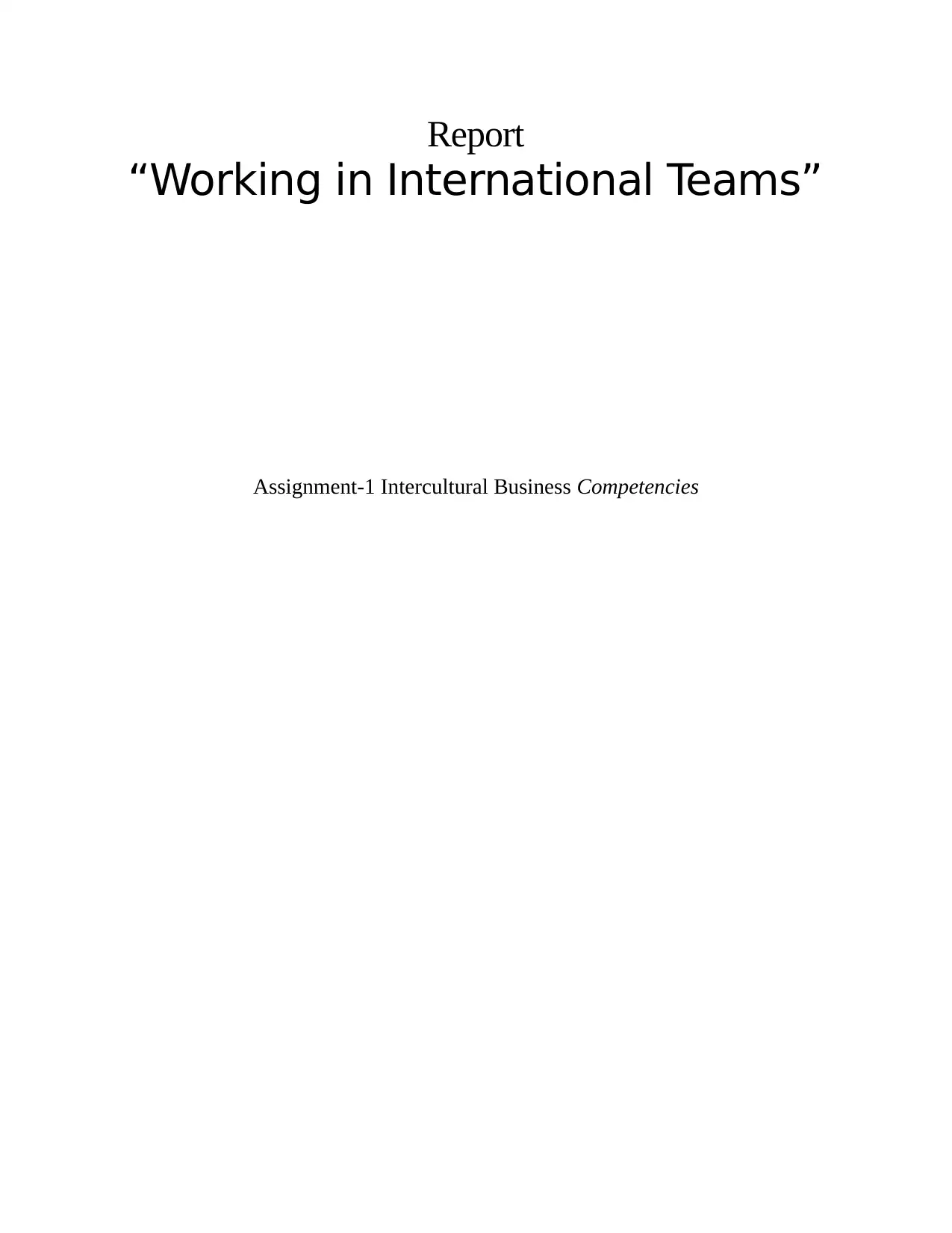
Report
“Working in International Teams”
Assignment-1 Intercultural Business Competencies
“Working in International Teams”
Assignment-1 Intercultural Business Competencies
Secure Best Marks with AI Grader
Need help grading? Try our AI Grader for instant feedback on your assignments.
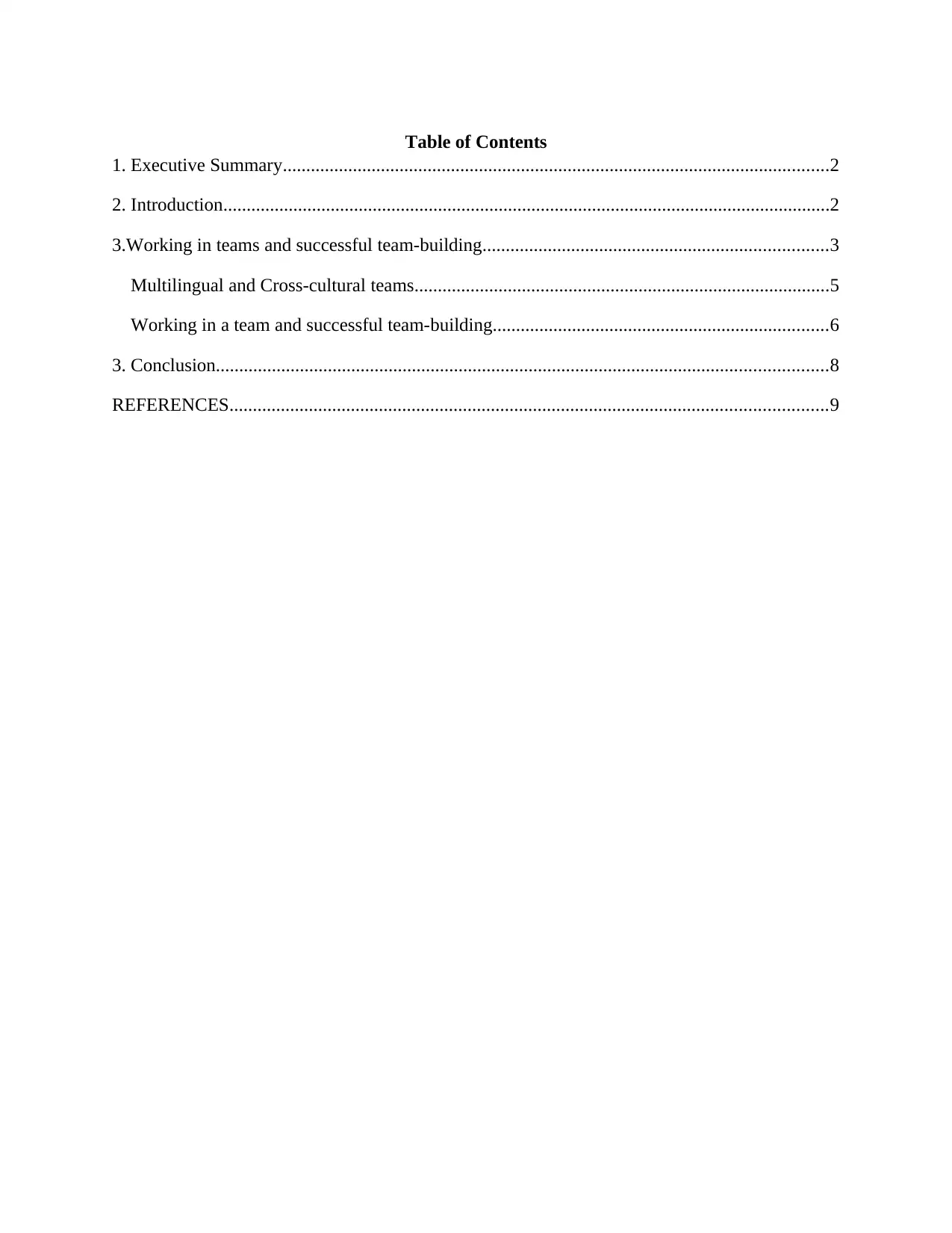
Table of Contents
1. Executive Summary.....................................................................................................................2
2. Introduction..................................................................................................................................2
3.Working in teams and successful team-building..........................................................................3
Multilingual and Cross-cultural teams.........................................................................................5
Working in a team and successful team-building........................................................................6
3. Conclusion...................................................................................................................................8
REFERENCES................................................................................................................................9
1. Executive Summary.....................................................................................................................2
2. Introduction..................................................................................................................................2
3.Working in teams and successful team-building..........................................................................3
Multilingual and Cross-cultural teams.........................................................................................5
Working in a team and successful team-building........................................................................6
3. Conclusion...................................................................................................................................8
REFERENCES................................................................................................................................9
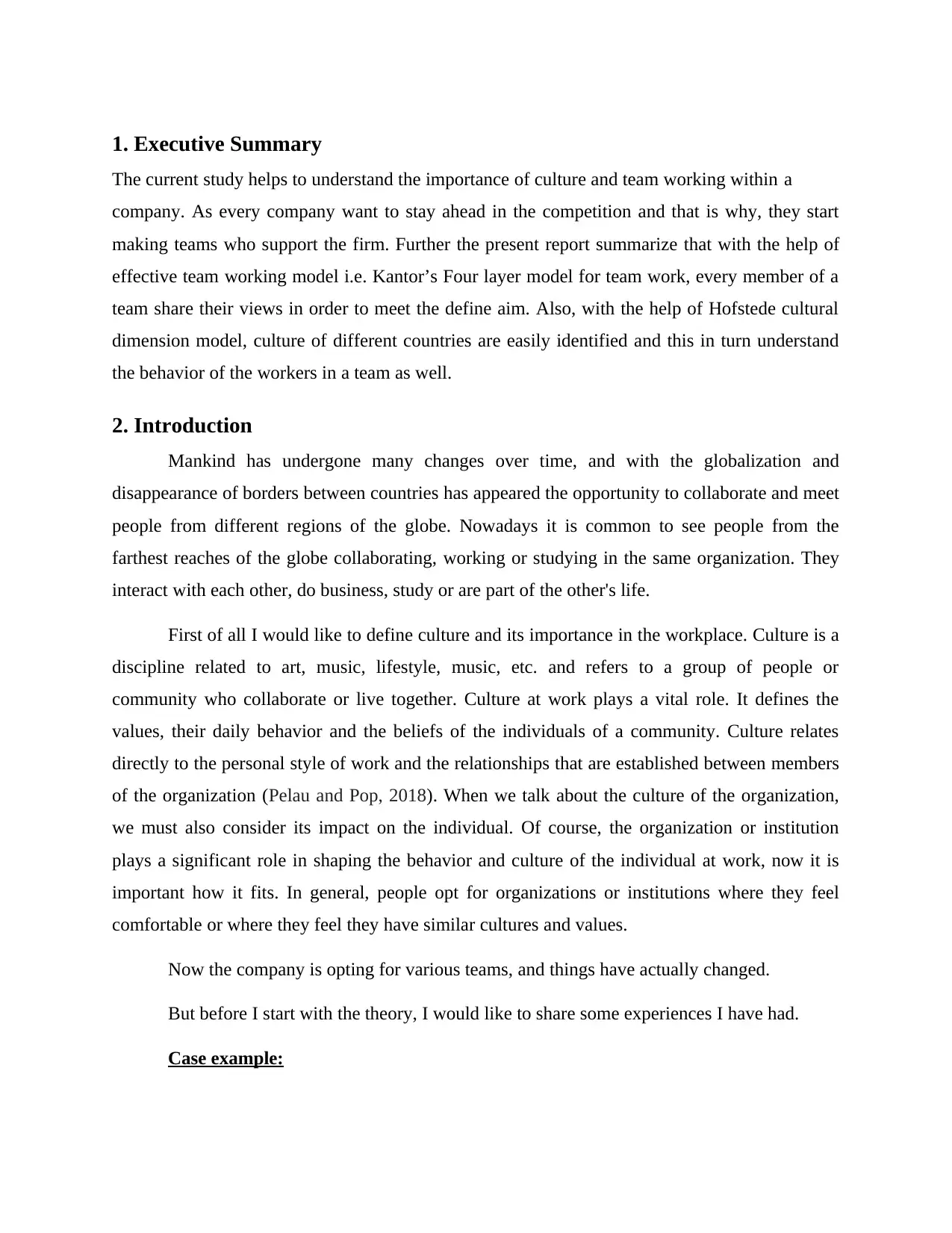
1. Executive Summary
The current study helps to understand the importance of culture and team working within a
company. As every company want to stay ahead in the competition and that is why, they start
making teams who support the firm. Further the present report summarize that with the help of
effective team working model i.e. Kantor’s Four layer model for team work, every member of a
team share their views in order to meet the define aim. Also, with the help of Hofstede cultural
dimension model, culture of different countries are easily identified and this in turn understand
the behavior of the workers in a team as well.
2. Introduction
Mankind has undergone many changes over time, and with the globalization and
disappearance of borders between countries has appeared the opportunity to collaborate and meet
people from different regions of the globe. Nowadays it is common to see people from the
farthest reaches of the globe collaborating, working or studying in the same organization. They
interact with each other, do business, study or are part of the other's life.
First of all I would like to define culture and its importance in the workplace. Culture is a
discipline related to art, music, lifestyle, music, etc. and refers to a group of people or
community who collaborate or live together. Culture at work plays a vital role. It defines the
values, their daily behavior and the beliefs of the individuals of a community. Culture relates
directly to the personal style of work and the relationships that are established between members
of the organization (Pelau and Pop, 2018). When we talk about the culture of the organization,
we must also consider its impact on the individual. Of course, the organization or institution
plays a significant role in shaping the behavior and culture of the individual at work, now it is
important how it fits. In general, people opt for organizations or institutions where they feel
comfortable or where they feel they have similar cultures and values.
Now the company is opting for various teams, and things have actually changed.
But before I start with the theory, I would like to share some experiences I have had.
Case example:
The current study helps to understand the importance of culture and team working within a
company. As every company want to stay ahead in the competition and that is why, they start
making teams who support the firm. Further the present report summarize that with the help of
effective team working model i.e. Kantor’s Four layer model for team work, every member of a
team share their views in order to meet the define aim. Also, with the help of Hofstede cultural
dimension model, culture of different countries are easily identified and this in turn understand
the behavior of the workers in a team as well.
2. Introduction
Mankind has undergone many changes over time, and with the globalization and
disappearance of borders between countries has appeared the opportunity to collaborate and meet
people from different regions of the globe. Nowadays it is common to see people from the
farthest reaches of the globe collaborating, working or studying in the same organization. They
interact with each other, do business, study or are part of the other's life.
First of all I would like to define culture and its importance in the workplace. Culture is a
discipline related to art, music, lifestyle, music, etc. and refers to a group of people or
community who collaborate or live together. Culture at work plays a vital role. It defines the
values, their daily behavior and the beliefs of the individuals of a community. Culture relates
directly to the personal style of work and the relationships that are established between members
of the organization (Pelau and Pop, 2018). When we talk about the culture of the organization,
we must also consider its impact on the individual. Of course, the organization or institution
plays a significant role in shaping the behavior and culture of the individual at work, now it is
important how it fits. In general, people opt for organizations or institutions where they feel
comfortable or where they feel they have similar cultures and values.
Now the company is opting for various teams, and things have actually changed.
But before I start with the theory, I would like to share some experiences I have had.
Case example:
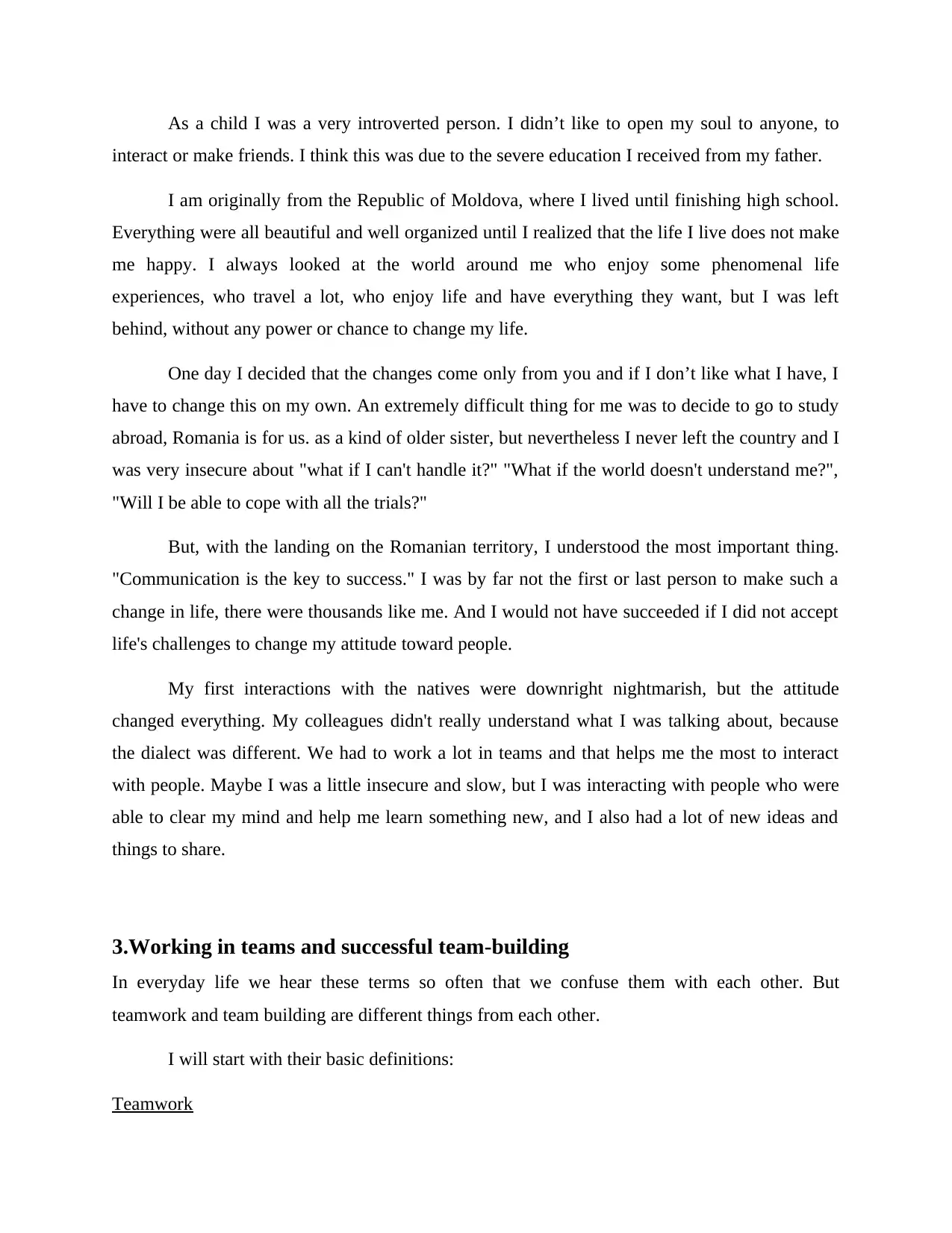
As a child I was a very introverted person. I didn’t like to open my soul to anyone, to
interact or make friends. I think this was due to the severe education I received from my father.
I am originally from the Republic of Moldova, where I lived until finishing high school.
Everything were all beautiful and well organized until I realized that the life I live does not make
me happy. I always looked at the world around me who enjoy some phenomenal life
experiences, who travel a lot, who enjoy life and have everything they want, but I was left
behind, without any power or chance to change my life.
One day I decided that the changes come only from you and if I don’t like what I have, I
have to change this on my own. An extremely difficult thing for me was to decide to go to study
abroad, Romania is for us. as a kind of older sister, but nevertheless I never left the country and I
was very insecure about "what if I can't handle it?" "What if the world doesn't understand me?",
"Will I be able to cope with all the trials?"
But, with the landing on the Romanian territory, I understood the most important thing.
"Communication is the key to success." I was by far not the first or last person to make such a
change in life, there were thousands like me. And I would not have succeeded if I did not accept
life's challenges to change my attitude toward people.
My first interactions with the natives were downright nightmarish, but the attitude
changed everything. My colleagues didn't really understand what I was talking about, because
the dialect was different. We had to work a lot in teams and that helps me the most to interact
with people. Maybe I was a little insecure and slow, but I was interacting with people who were
able to clear my mind and help me learn something new, and I also had a lot of new ideas and
things to share.
3.Working in teams and successful team-building
In everyday life we hear these terms so often that we confuse them with each other. But
teamwork and team building are different things from each other.
I will start with their basic definitions:
Teamwork
interact or make friends. I think this was due to the severe education I received from my father.
I am originally from the Republic of Moldova, where I lived until finishing high school.
Everything were all beautiful and well organized until I realized that the life I live does not make
me happy. I always looked at the world around me who enjoy some phenomenal life
experiences, who travel a lot, who enjoy life and have everything they want, but I was left
behind, without any power or chance to change my life.
One day I decided that the changes come only from you and if I don’t like what I have, I
have to change this on my own. An extremely difficult thing for me was to decide to go to study
abroad, Romania is for us. as a kind of older sister, but nevertheless I never left the country and I
was very insecure about "what if I can't handle it?" "What if the world doesn't understand me?",
"Will I be able to cope with all the trials?"
But, with the landing on the Romanian territory, I understood the most important thing.
"Communication is the key to success." I was by far not the first or last person to make such a
change in life, there were thousands like me. And I would not have succeeded if I did not accept
life's challenges to change my attitude toward people.
My first interactions with the natives were downright nightmarish, but the attitude
changed everything. My colleagues didn't really understand what I was talking about, because
the dialect was different. We had to work a lot in teams and that helps me the most to interact
with people. Maybe I was a little insecure and slow, but I was interacting with people who were
able to clear my mind and help me learn something new, and I also had a lot of new ideas and
things to share.
3.Working in teams and successful team-building
In everyday life we hear these terms so often that we confuse them with each other. But
teamwork and team building are different things from each other.
I will start with their basic definitions:
Teamwork
Secure Best Marks with AI Grader
Need help grading? Try our AI Grader for instant feedback on your assignments.
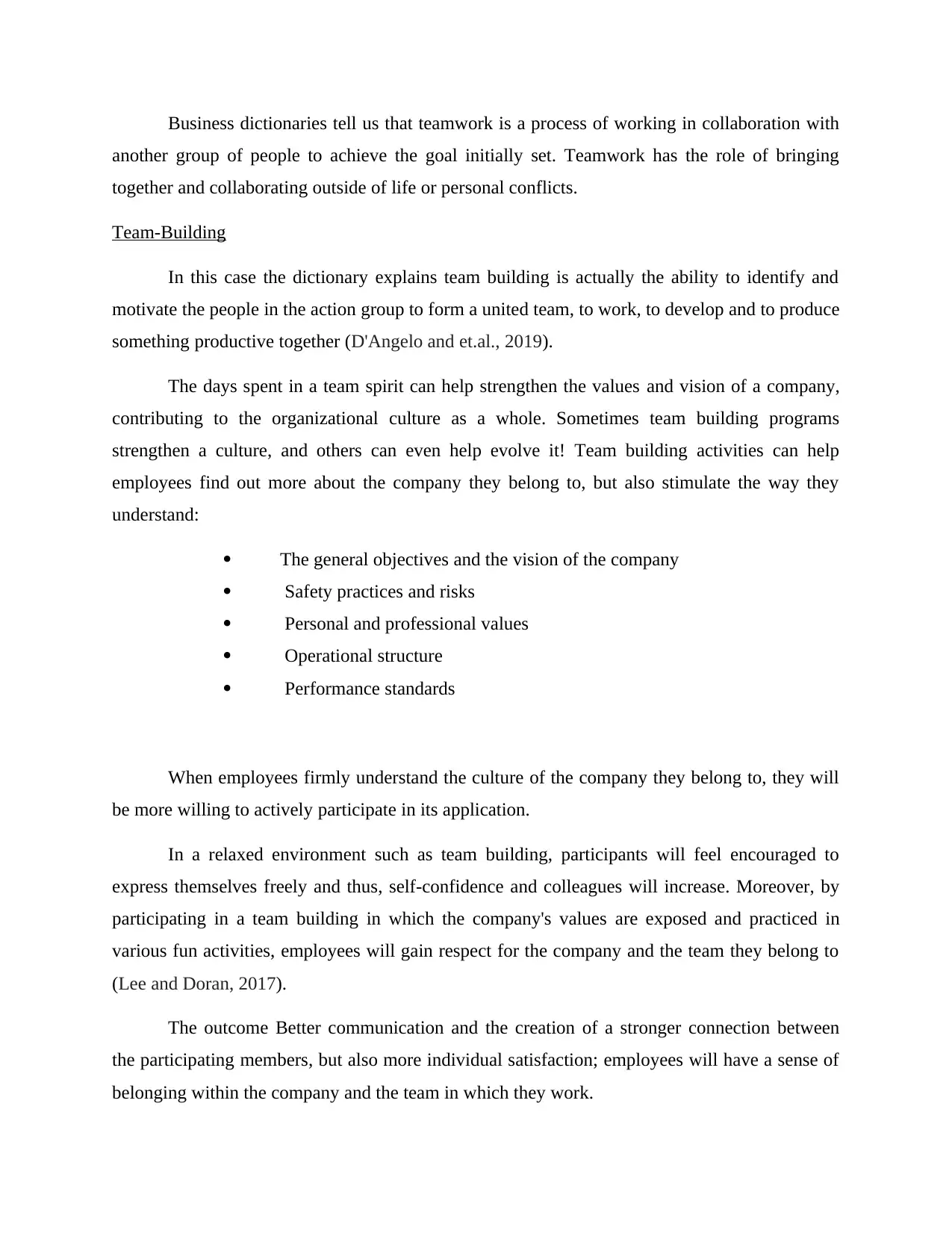
Business dictionaries tell us that teamwork is a process of working in collaboration with
another group of people to achieve the goal initially set. Teamwork has the role of bringing
together and collaborating outside of life or personal conflicts.
Team-Building
In this case the dictionary explains team building is actually the ability to identify and
motivate the people in the action group to form a united team, to work, to develop and to produce
something productive together (D'Angelo and et.al., 2019).
The days spent in a team spirit can help strengthen the values and vision of a company,
contributing to the organizational culture as a whole. Sometimes team building programs
strengthen a culture, and others can even help evolve it! Team building activities can help
employees find out more about the company they belong to, but also stimulate the way they
understand:
The general objectives and the vision of the company
Safety practices and risks
Personal and professional values
Operational structure
Performance standards
When employees firmly understand the culture of the company they belong to, they will
be more willing to actively participate in its application.
In a relaxed environment such as team building, participants will feel encouraged to
express themselves freely and thus, self-confidence and colleagues will increase. Moreover, by
participating in a team building in which the company's values are exposed and practiced in
various fun activities, employees will gain respect for the company and the team they belong to
(Lee and Doran, 2017).
The outcome Better communication and the creation of a stronger connection between
the participating members, but also more individual satisfaction; employees will have a sense of
belonging within the company and the team in which they work.
another group of people to achieve the goal initially set. Teamwork has the role of bringing
together and collaborating outside of life or personal conflicts.
Team-Building
In this case the dictionary explains team building is actually the ability to identify and
motivate the people in the action group to form a united team, to work, to develop and to produce
something productive together (D'Angelo and et.al., 2019).
The days spent in a team spirit can help strengthen the values and vision of a company,
contributing to the organizational culture as a whole. Sometimes team building programs
strengthen a culture, and others can even help evolve it! Team building activities can help
employees find out more about the company they belong to, but also stimulate the way they
understand:
The general objectives and the vision of the company
Safety practices and risks
Personal and professional values
Operational structure
Performance standards
When employees firmly understand the culture of the company they belong to, they will
be more willing to actively participate in its application.
In a relaxed environment such as team building, participants will feel encouraged to
express themselves freely and thus, self-confidence and colleagues will increase. Moreover, by
participating in a team building in which the company's values are exposed and practiced in
various fun activities, employees will gain respect for the company and the team they belong to
(Lee and Doran, 2017).
The outcome Better communication and the creation of a stronger connection between
the participating members, but also more individual satisfaction; employees will have a sense of
belonging within the company and the team in which they work.
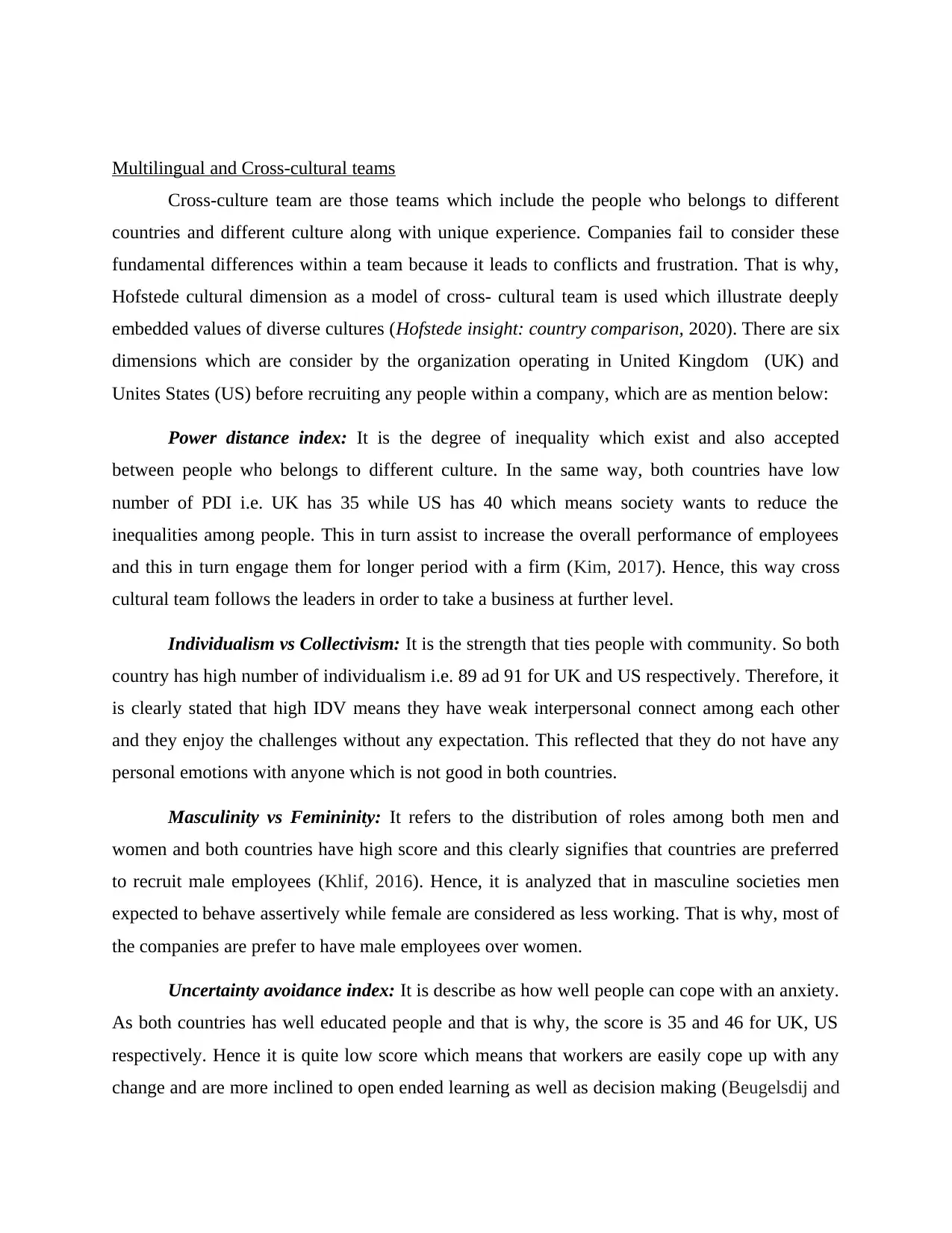
Multilingual and Cross-cultural teams
Cross-culture team are those teams which include the people who belongs to different
countries and different culture along with unique experience. Companies fail to consider these
fundamental differences within a team because it leads to conflicts and frustration. That is why,
Hofstede cultural dimension as a model of cross- cultural team is used which illustrate deeply
embedded values of diverse cultures (Hofstede insight: country comparison, 2020). There are six
dimensions which are consider by the organization operating in United Kingdom (UK) and
Unites States (US) before recruiting any people within a company, which are as mention below:
Power distance index: It is the degree of inequality which exist and also accepted
between people who belongs to different culture. In the same way, both countries have low
number of PDI i.e. UK has 35 while US has 40 which means society wants to reduce the
inequalities among people. This in turn assist to increase the overall performance of employees
and this in turn engage them for longer period with a firm (Kim, 2017). Hence, this way cross
cultural team follows the leaders in order to take a business at further level.
Individualism vs Collectivism: It is the strength that ties people with community. So both
country has high number of individualism i.e. 89 ad 91 for UK and US respectively. Therefore, it
is clearly stated that high IDV means they have weak interpersonal connect among each other
and they enjoy the challenges without any expectation. This reflected that they do not have any
personal emotions with anyone which is not good in both countries.
Masculinity vs Femininity: It refers to the distribution of roles among both men and
women and both countries have high score and this clearly signifies that countries are preferred
to recruit male employees (Khlif, 2016). Hence, it is analyzed that in masculine societies men
expected to behave assertively while female are considered as less working. That is why, most of
the companies are prefer to have male employees over women.
Uncertainty avoidance index: It is describe as how well people can cope with an anxiety.
As both countries has well educated people and that is why, the score is 35 and 46 for UK, US
respectively. Hence it is quite low score which means that workers are easily cope up with any
change and are more inclined to open ended learning as well as decision making (Beugelsdij and
Cross-culture team are those teams which include the people who belongs to different
countries and different culture along with unique experience. Companies fail to consider these
fundamental differences within a team because it leads to conflicts and frustration. That is why,
Hofstede cultural dimension as a model of cross- cultural team is used which illustrate deeply
embedded values of diverse cultures (Hofstede insight: country comparison, 2020). There are six
dimensions which are consider by the organization operating in United Kingdom (UK) and
Unites States (US) before recruiting any people within a company, which are as mention below:
Power distance index: It is the degree of inequality which exist and also accepted
between people who belongs to different culture. In the same way, both countries have low
number of PDI i.e. UK has 35 while US has 40 which means society wants to reduce the
inequalities among people. This in turn assist to increase the overall performance of employees
and this in turn engage them for longer period with a firm (Kim, 2017). Hence, this way cross
cultural team follows the leaders in order to take a business at further level.
Individualism vs Collectivism: It is the strength that ties people with community. So both
country has high number of individualism i.e. 89 ad 91 for UK and US respectively. Therefore, it
is clearly stated that high IDV means they have weak interpersonal connect among each other
and they enjoy the challenges without any expectation. This reflected that they do not have any
personal emotions with anyone which is not good in both countries.
Masculinity vs Femininity: It refers to the distribution of roles among both men and
women and both countries have high score and this clearly signifies that countries are preferred
to recruit male employees (Khlif, 2016). Hence, it is analyzed that in masculine societies men
expected to behave assertively while female are considered as less working. That is why, most of
the companies are prefer to have male employees over women.
Uncertainty avoidance index: It is describe as how well people can cope with an anxiety.
As both countries has well educated people and that is why, the score is 35 and 46 for UK, US
respectively. Hence it is quite low score which means that workers are easily cope up with any
change and are more inclined to open ended learning as well as decision making (Beugelsdij and
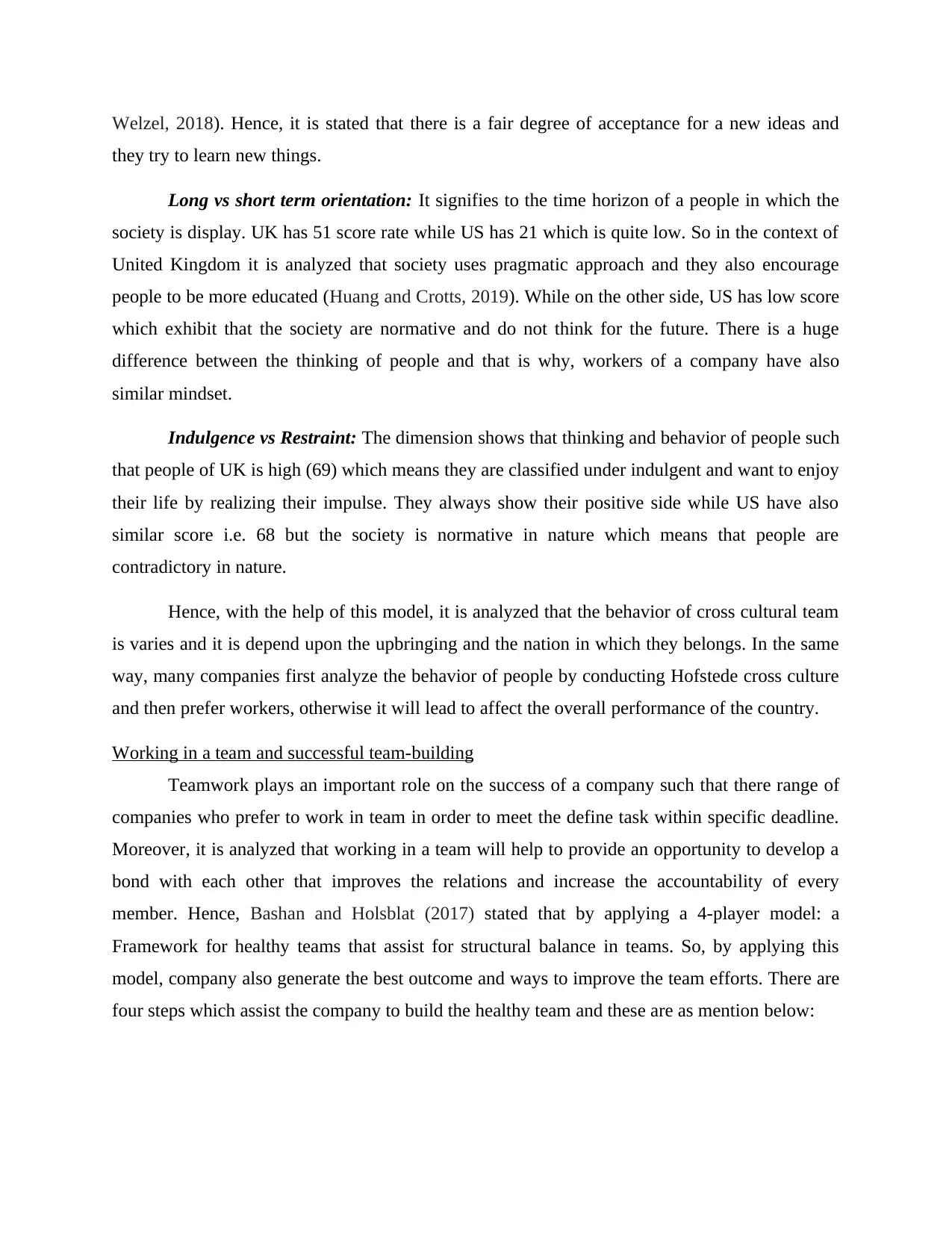
Welzel, 2018). Hence, it is stated that there is a fair degree of acceptance for a new ideas and
they try to learn new things.
Long vs short term orientation: It signifies to the time horizon of a people in which the
society is display. UK has 51 score rate while US has 21 which is quite low. So in the context of
United Kingdom it is analyzed that society uses pragmatic approach and they also encourage
people to be more educated (Huang and Crotts, 2019). While on the other side, US has low score
which exhibit that the society are normative and do not think for the future. There is a huge
difference between the thinking of people and that is why, workers of a company have also
similar mindset.
Indulgence vs Restraint: The dimension shows that thinking and behavior of people such
that people of UK is high (69) which means they are classified under indulgent and want to enjoy
their life by realizing their impulse. They always show their positive side while US have also
similar score i.e. 68 but the society is normative in nature which means that people are
contradictory in nature.
Hence, with the help of this model, it is analyzed that the behavior of cross cultural team
is varies and it is depend upon the upbringing and the nation in which they belongs. In the same
way, many companies first analyze the behavior of people by conducting Hofstede cross culture
and then prefer workers, otherwise it will lead to affect the overall performance of the country.
Working in a team and successful team-building
Teamwork plays an important role on the success of a company such that there range of
companies who prefer to work in team in order to meet the define task within specific deadline.
Moreover, it is analyzed that working in a team will help to provide an opportunity to develop a
bond with each other that improves the relations and increase the accountability of every
member. Hence, Bashan and Holsblat (2017) stated that by applying a 4-player model: a
Framework for healthy teams that assist for structural balance in teams. So, by applying this
model, company also generate the best outcome and ways to improve the team efforts. There are
four steps which assist the company to build the healthy team and these are as mention below:
they try to learn new things.
Long vs short term orientation: It signifies to the time horizon of a people in which the
society is display. UK has 51 score rate while US has 21 which is quite low. So in the context of
United Kingdom it is analyzed that society uses pragmatic approach and they also encourage
people to be more educated (Huang and Crotts, 2019). While on the other side, US has low score
which exhibit that the society are normative and do not think for the future. There is a huge
difference between the thinking of people and that is why, workers of a company have also
similar mindset.
Indulgence vs Restraint: The dimension shows that thinking and behavior of people such
that people of UK is high (69) which means they are classified under indulgent and want to enjoy
their life by realizing their impulse. They always show their positive side while US have also
similar score i.e. 68 but the society is normative in nature which means that people are
contradictory in nature.
Hence, with the help of this model, it is analyzed that the behavior of cross cultural team
is varies and it is depend upon the upbringing and the nation in which they belongs. In the same
way, many companies first analyze the behavior of people by conducting Hofstede cross culture
and then prefer workers, otherwise it will lead to affect the overall performance of the country.
Working in a team and successful team-building
Teamwork plays an important role on the success of a company such that there range of
companies who prefer to work in team in order to meet the define task within specific deadline.
Moreover, it is analyzed that working in a team will help to provide an opportunity to develop a
bond with each other that improves the relations and increase the accountability of every
member. Hence, Bashan and Holsblat (2017) stated that by applying a 4-player model: a
Framework for healthy teams that assist for structural balance in teams. So, by applying this
model, company also generate the best outcome and ways to improve the team efforts. There are
four steps which assist the company to build the healthy team and these are as mention below:
Paraphrase This Document
Need a fresh take? Get an instant paraphrase of this document with our AI Paraphraser
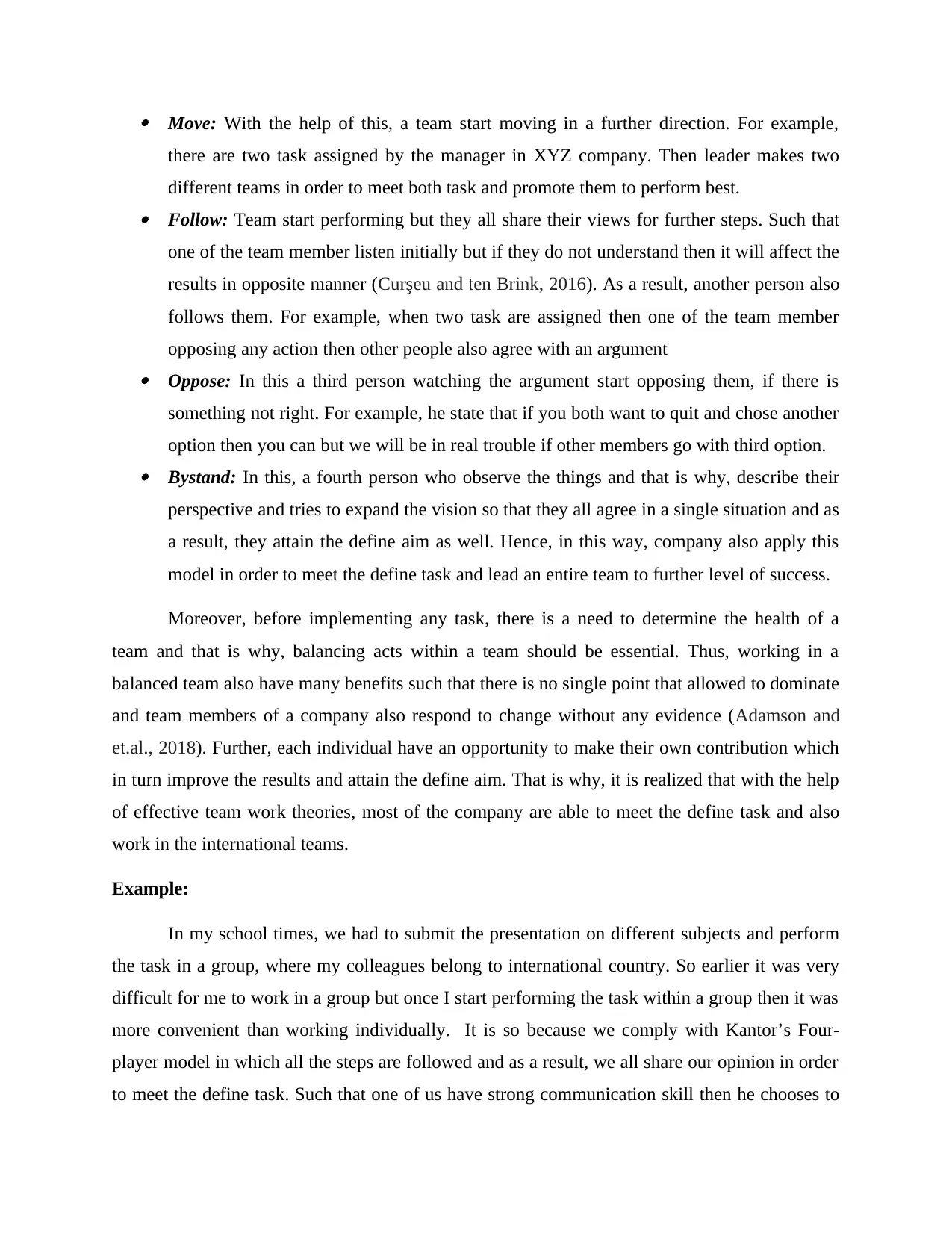
Move: With the help of this, a team start moving in a further direction. For example,
there are two task assigned by the manager in XYZ company. Then leader makes two
different teams in order to meet both task and promote them to perform best. Follow: Team start performing but they all share their views for further steps. Such that
one of the team member listen initially but if they do not understand then it will affect the
results in opposite manner (Curşeu and ten Brink, 2016). As a result, another person also
follows them. For example, when two task are assigned then one of the team member
opposing any action then other people also agree with an argument Oppose: In this a third person watching the argument start opposing them, if there is
something not right. For example, he state that if you both want to quit and chose another
option then you can but we will be in real trouble if other members go with third option. Bystand: In this, a fourth person who observe the things and that is why, describe their
perspective and tries to expand the vision so that they all agree in a single situation and as
a result, they attain the define aim as well. Hence, in this way, company also apply this
model in order to meet the define task and lead an entire team to further level of success.
Moreover, before implementing any task, there is a need to determine the health of a
team and that is why, balancing acts within a team should be essential. Thus, working in a
balanced team also have many benefits such that there is no single point that allowed to dominate
and team members of a company also respond to change without any evidence (Adamson and
et.al., 2018). Further, each individual have an opportunity to make their own contribution which
in turn improve the results and attain the define aim. That is why, it is realized that with the help
of effective team work theories, most of the company are able to meet the define task and also
work in the international teams.
Example:
In my school times, we had to submit the presentation on different subjects and perform
the task in a group, where my colleagues belong to international country. So earlier it was very
difficult for me to work in a group but once I start performing the task within a group then it was
more convenient than working individually. It is so because we comply with Kantor’s Four-
player model in which all the steps are followed and as a result, we all share our opinion in order
to meet the define task. Such that one of us have strong communication skill then he chooses to
there are two task assigned by the manager in XYZ company. Then leader makes two
different teams in order to meet both task and promote them to perform best. Follow: Team start performing but they all share their views for further steps. Such that
one of the team member listen initially but if they do not understand then it will affect the
results in opposite manner (Curşeu and ten Brink, 2016). As a result, another person also
follows them. For example, when two task are assigned then one of the team member
opposing any action then other people also agree with an argument Oppose: In this a third person watching the argument start opposing them, if there is
something not right. For example, he state that if you both want to quit and chose another
option then you can but we will be in real trouble if other members go with third option. Bystand: In this, a fourth person who observe the things and that is why, describe their
perspective and tries to expand the vision so that they all agree in a single situation and as
a result, they attain the define aim as well. Hence, in this way, company also apply this
model in order to meet the define task and lead an entire team to further level of success.
Moreover, before implementing any task, there is a need to determine the health of a
team and that is why, balancing acts within a team should be essential. Thus, working in a
balanced team also have many benefits such that there is no single point that allowed to dominate
and team members of a company also respond to change without any evidence (Adamson and
et.al., 2018). Further, each individual have an opportunity to make their own contribution which
in turn improve the results and attain the define aim. That is why, it is realized that with the help
of effective team work theories, most of the company are able to meet the define task and also
work in the international teams.
Example:
In my school times, we had to submit the presentation on different subjects and perform
the task in a group, where my colleagues belong to international country. So earlier it was very
difficult for me to work in a group but once I start performing the task within a group then it was
more convenient than working individually. It is so because we comply with Kantor’s Four-
player model in which all the steps are followed and as a result, we all share our opinion in order
to meet the define task. Such that one of us have strong communication skill then he chooses to
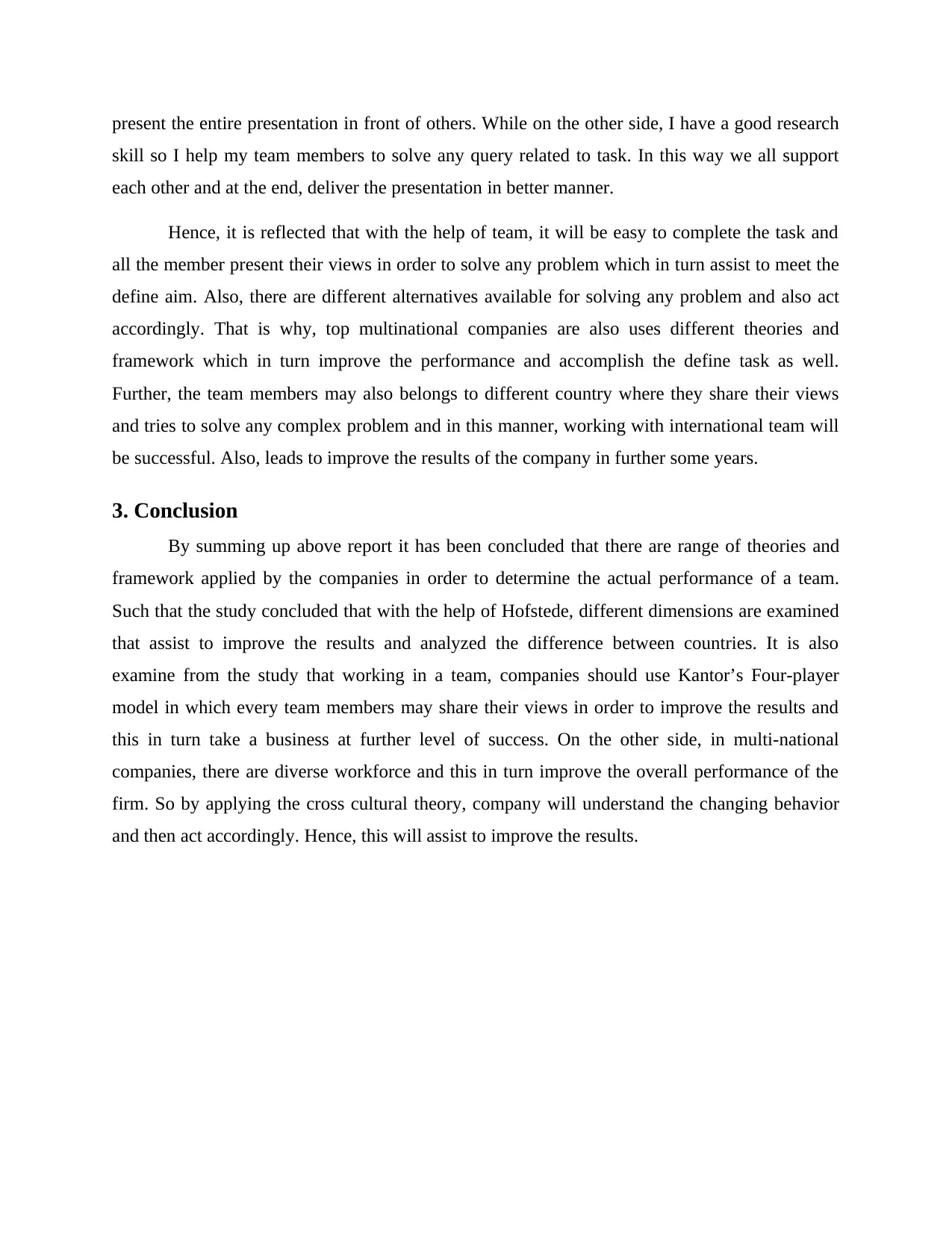
present the entire presentation in front of others. While on the other side, I have a good research
skill so I help my team members to solve any query related to task. In this way we all support
each other and at the end, deliver the presentation in better manner.
Hence, it is reflected that with the help of team, it will be easy to complete the task and
all the member present their views in order to solve any problem which in turn assist to meet the
define aim. Also, there are different alternatives available for solving any problem and also act
accordingly. That is why, top multinational companies are also uses different theories and
framework which in turn improve the performance and accomplish the define task as well.
Further, the team members may also belongs to different country where they share their views
and tries to solve any complex problem and in this manner, working with international team will
be successful. Also, leads to improve the results of the company in further some years.
3. Conclusion
By summing up above report it has been concluded that there are range of theories and
framework applied by the companies in order to determine the actual performance of a team.
Such that the study concluded that with the help of Hofstede, different dimensions are examined
that assist to improve the results and analyzed the difference between countries. It is also
examine from the study that working in a team, companies should use Kantor’s Four-player
model in which every team members may share their views in order to improve the results and
this in turn take a business at further level of success. On the other side, in multi-national
companies, there are diverse workforce and this in turn improve the overall performance of the
firm. So by applying the cross cultural theory, company will understand the changing behavior
and then act accordingly. Hence, this will assist to improve the results.
skill so I help my team members to solve any query related to task. In this way we all support
each other and at the end, deliver the presentation in better manner.
Hence, it is reflected that with the help of team, it will be easy to complete the task and
all the member present their views in order to solve any problem which in turn assist to meet the
define aim. Also, there are different alternatives available for solving any problem and also act
accordingly. That is why, top multinational companies are also uses different theories and
framework which in turn improve the performance and accomplish the define task as well.
Further, the team members may also belongs to different country where they share their views
and tries to solve any complex problem and in this manner, working with international team will
be successful. Also, leads to improve the results of the company in further some years.
3. Conclusion
By summing up above report it has been concluded that there are range of theories and
framework applied by the companies in order to determine the actual performance of a team.
Such that the study concluded that with the help of Hofstede, different dimensions are examined
that assist to improve the results and analyzed the difference between countries. It is also
examine from the study that working in a team, companies should use Kantor’s Four-player
model in which every team members may share their views in order to improve the results and
this in turn take a business at further level of success. On the other side, in multi-national
companies, there are diverse workforce and this in turn improve the overall performance of the
firm. So by applying the cross cultural theory, company will understand the changing behavior
and then act accordingly. Hence, this will assist to improve the results.
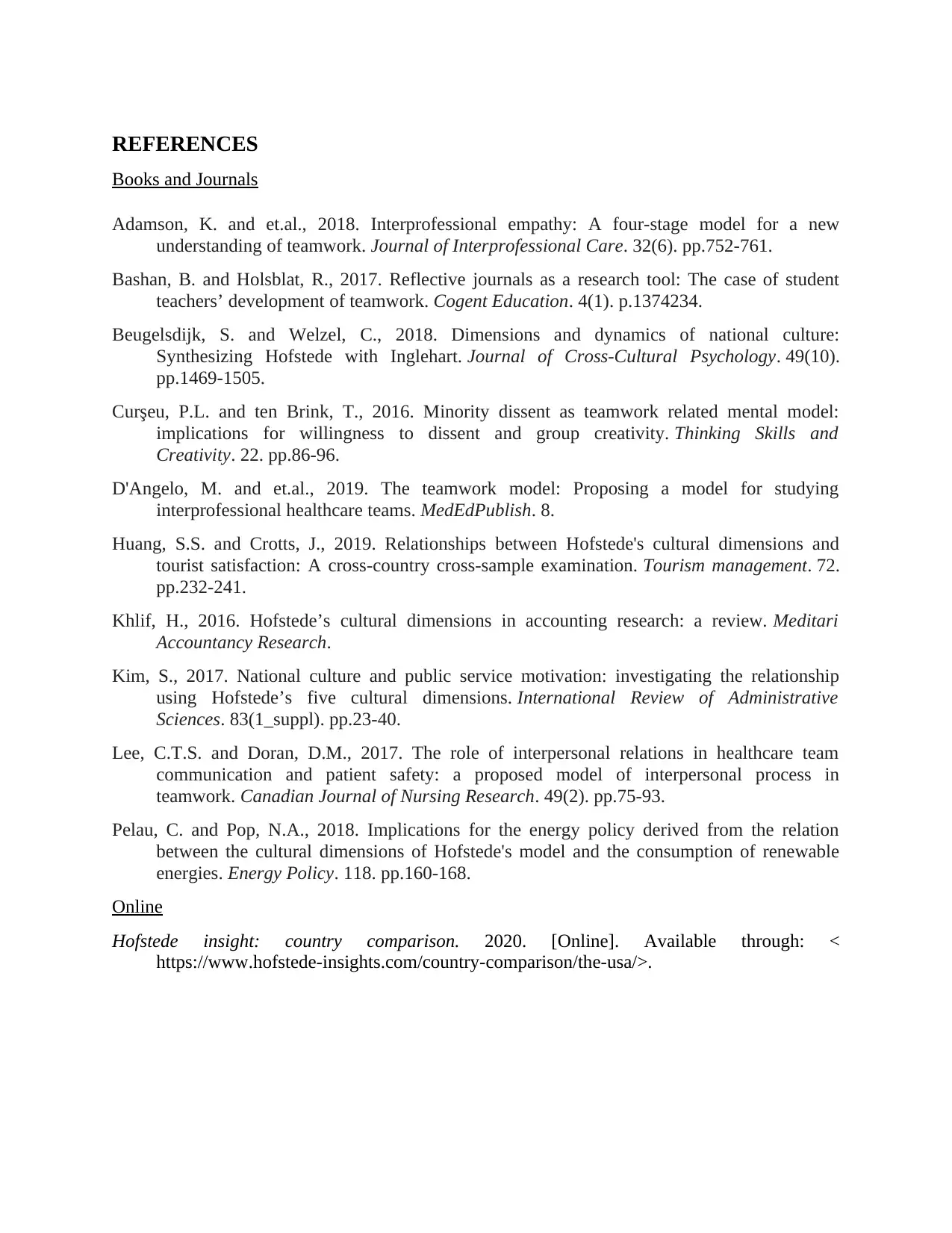
REFERENCES
Books and Journals
Adamson, K. and et.al., 2018. Interprofessional empathy: A four-stage model for a new
understanding of teamwork. Journal of Interprofessional Care. 32(6). pp.752-761.
Bashan, B. and Holsblat, R., 2017. Reflective journals as a research tool: The case of student
teachers’ development of teamwork. Cogent Education. 4(1). p.1374234.
Beugelsdijk, S. and Welzel, C., 2018. Dimensions and dynamics of national culture:
Synthesizing Hofstede with Inglehart. Journal of Cross-Cultural Psychology. 49(10).
pp.1469-1505.
Curşeu, P.L. and ten Brink, T., 2016. Minority dissent as teamwork related mental model:
implications for willingness to dissent and group creativity. Thinking Skills and
Creativity. 22. pp.86-96.
D'Angelo, M. and et.al., 2019. The teamwork model: Proposing a model for studying
interprofessional healthcare teams. MedEdPublish. 8.
Huang, S.S. and Crotts, J., 2019. Relationships between Hofstede's cultural dimensions and
tourist satisfaction: A cross-country cross-sample examination. Tourism management. 72.
pp.232-241.
Khlif, H., 2016. Hofstede’s cultural dimensions in accounting research: a review. Meditari
Accountancy Research.
Kim, S., 2017. National culture and public service motivation: investigating the relationship
using Hofstede’s five cultural dimensions. International Review of Administrative
Sciences. 83(1_suppl). pp.23-40.
Lee, C.T.S. and Doran, D.M., 2017. The role of interpersonal relations in healthcare team
communication and patient safety: a proposed model of interpersonal process in
teamwork. Canadian Journal of Nursing Research. 49(2). pp.75-93.
Pelau, C. and Pop, N.A., 2018. Implications for the energy policy derived from the relation
between the cultural dimensions of Hofstede's model and the consumption of renewable
energies. Energy Policy. 118. pp.160-168.
Online
Hofstede insight: country comparison. 2020. [Online]. Available through: <
https://www.hofstede-insights.com/country-comparison/the-usa/>.
Books and Journals
Adamson, K. and et.al., 2018. Interprofessional empathy: A four-stage model for a new
understanding of teamwork. Journal of Interprofessional Care. 32(6). pp.752-761.
Bashan, B. and Holsblat, R., 2017. Reflective journals as a research tool: The case of student
teachers’ development of teamwork. Cogent Education. 4(1). p.1374234.
Beugelsdijk, S. and Welzel, C., 2018. Dimensions and dynamics of national culture:
Synthesizing Hofstede with Inglehart. Journal of Cross-Cultural Psychology. 49(10).
pp.1469-1505.
Curşeu, P.L. and ten Brink, T., 2016. Minority dissent as teamwork related mental model:
implications for willingness to dissent and group creativity. Thinking Skills and
Creativity. 22. pp.86-96.
D'Angelo, M. and et.al., 2019. The teamwork model: Proposing a model for studying
interprofessional healthcare teams. MedEdPublish. 8.
Huang, S.S. and Crotts, J., 2019. Relationships between Hofstede's cultural dimensions and
tourist satisfaction: A cross-country cross-sample examination. Tourism management. 72.
pp.232-241.
Khlif, H., 2016. Hofstede’s cultural dimensions in accounting research: a review. Meditari
Accountancy Research.
Kim, S., 2017. National culture and public service motivation: investigating the relationship
using Hofstede’s five cultural dimensions. International Review of Administrative
Sciences. 83(1_suppl). pp.23-40.
Lee, C.T.S. and Doran, D.M., 2017. The role of interpersonal relations in healthcare team
communication and patient safety: a proposed model of interpersonal process in
teamwork. Canadian Journal of Nursing Research. 49(2). pp.75-93.
Pelau, C. and Pop, N.A., 2018. Implications for the energy policy derived from the relation
between the cultural dimensions of Hofstede's model and the consumption of renewable
energies. Energy Policy. 118. pp.160-168.
Online
Hofstede insight: country comparison. 2020. [Online]. Available through: <
https://www.hofstede-insights.com/country-comparison/the-usa/>.
Secure Best Marks with AI Grader
Need help grading? Try our AI Grader for instant feedback on your assignments.

1 out of 11
Related Documents
Your All-in-One AI-Powered Toolkit for Academic Success.
+13062052269
info@desklib.com
Available 24*7 on WhatsApp / Email
![[object Object]](/_next/static/media/star-bottom.7253800d.svg)
Unlock your academic potential
© 2024 | Zucol Services PVT LTD | All rights reserved.





